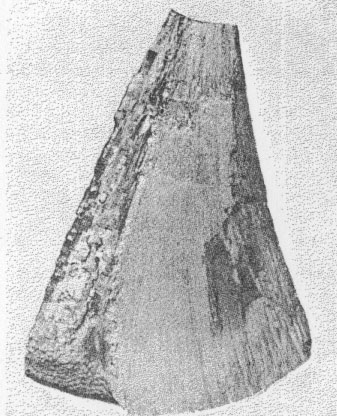| Home | AmMin | GMR | RiMG | Collectors Corner | Directory | Short Courses | |
|
|
|||||||

|
|
Volume 19, pages 385-388, 1934 FIBROUS PYRITE FROM THE LEAD-ZINC DISTRICT OF ILLINOIS KENDALL E. BORN, Washington University. INTRODUCTION Marcasite has been recognized by Bain1 and other workers as an abundant gangue mineral in the lead and zinc deposits of southwestern Wisconsin and adjoining parts of Illinois and Iowa. Pyrite has also been recognized and described, but it has been considered less abundant than marcasite. The two iron sulphides are intimately associated with the galena and sphalerite which occur as crevice and fissure fillings in the Galena dolomite of Ordovician age. The present paper describes pyrite with a distinctly fibrous structure and suggests that this mineral is far more abundant than hitherto recognized. The specimens which form the basis for these conclusions were collected from the Eadie Mine, near Hanover, Illinois, and the Blackjack Mine, about 3 miles south of Galena, Illinois, and are now in the mineral collections of the Department of Geology and Geography, Washington University. Professor O. R. Grawe of the School of Mines and Metallurgy, University of Missouri, first noted the true nature of this material. The specimens were referred to the writer for further study and investigation by Professor W. D. Shipton, Department of Geology and Geography, Washington University. Professors Grawe, Shipton, and Charles H. Behre, Jr. of the Department of Geology and Geography, Northwestern University, have read the manuscript and their suggestions and criticisms are gratefully acknowledged. IDENTIFICATION OF THE PYRITE Many methods of distinguishing pyrite from marcasite have been suggested. Stokes2 proposed a chemical method based upon oxidation, and Allen, Crenshaw, Johnston, and Larsen3 have recorded a detailed treatment of the iron sulphides. More recently x-rays have been employed with excellent results in the differentiation of these two sulphides of iron.4 Several polished sections of the fibrous mineral from the Eadie Mine were made by the writer for study. Each polished section was definitely isotropic and in only one section was a possible intergrowth of the pyrite and marcasite suggested. Weakly anisotropic pyrite has been reported, but according to Bannister, 5 it may be clearly distinguished from the distinctly anisotropic character of marcasite.A series of specific gravity determinations by the pycnometer method ranged from 4.97-5.14. When boiled in a weak (3 per cent) solution of silver nitrate, the mineral was tarnished a light brown in color; this color persisted. Marcasite tarnished brown, then red, and finally blue under the same conditions. The nitric acid test gave very little free sulphur after warming. Marcasite characteristically gives abundant free sulphur when the mineral is dissolved in nitric acid.DESCRIPTION OF THE PYRITE Most of the specimens of iron sulphide from the Eadie Mine, a very shallow working, display a radiating fibrous structure, some show a distinctly bladed structure and gradations of these two types are very common. In this respect, as well as its light silvery color, the mineral strongly suggests marcasite. A gradation from cubic crystals through a more or less bladed structure to a definitely fibrous structure was noted in one of the specimens (Fig. 1). Greater elongation of the faces of the cube in one direction explains this fibrous appearance. Small individual cubes modified by the octahedron and pyritohedron were noted on several specimens of the fibrous pyrite.
One specimen from the Blackjack Mine was composed of a group of roughly symmetrically developed cubes made up of columnar individuals in a radial arrangement about a common center. Hobbs 7 observed this form of pyrite in the Galena district as early as 1895. He described cubes of pyrite developed in the direction of one of the principal axes and concluded that "the large radial sheaves of iron sulphide which occur at Galena are for the most part pyrite." However, since specimens showing this columnar development of the cube are not common in the lead and zinc region of the Upper Mississippi Valley, it appears that much of the fibrous iron sulphide has been referred to as marcasite. Van Horn8 has stated that acicular iron sulphides have been termed marcasite, probably upon the basis that an orthorhombic mineral might assume this habit more readily than an isometric mineral.SUMMARY The present study points to the fact that some of the fibrous iron sulphide found in the lead-zinc district of the Upper Mississippi Valley has been erroneously termed marcasite. Marcasite has been reported to be the most abundant iron sulphide in the area. While this contention may be correct, it seems logical to raise the question whether the amount of pyrite present has not been greatly underestimated. NOTES 1 Bain, H. F., Zinc and Lead Deposits of the Upper Mississippi Valley: U. S. Geol. Survey, Bull. 294, p. 49, 1906. 2 Stokes, H. N., On Pyrite and Marcasite: U. S. Geol. Survey, Bull. 186, 1901. 3 Allen, E. T., Crenshaw, J. L., Johnston, John and Larsen, E. S., The Mineral Suphides of Iron: Ant. Jour. Science, vol. 33, pp. 169-236, 1912. 4 Bannister, F. A., The Distinction of Pyrite from Marcasite in Nodular Growths: Mineralogical Mag., vol. 23, pp. 179-187, Sept., 1932. Van Horn, F. R., and Van Horn, K. R., X-ray Study of Pyrite or Marcasite Concretions in the Rocks of the Cleveland, Ohio, Quadrangles: Amer. Mineralogist, vol. 18, No. 7, pp. 288-294, 1933. 5 Op. cit., p. 186. 6 Dana, E. S., and Ford, W. E., A Textbook of Mineralogy (4th Ed.) : John Wiley & Sons, New York, p. 438, 1932. 7 Hobbs, W. H., A Contribution to the Mineralogy of Wisconsin: Univ. of Wisconsin Bull., Science Series, vol. 1, No. 4, p. 145, 1895. 8 Op. cit., p. 288.
|
